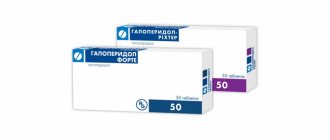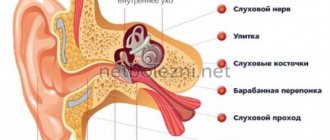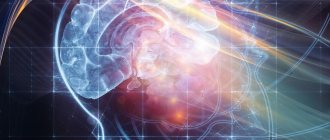Pharmacological properties of the drug Finlepsin retard
Pharmacodynamics . Anticonvulsant, derivative of tricyclic iminostilbene. It has a moderate antidepressant and normothymic effect. The therapeutic effect is primarily due to the inhibition of synaptic transmission of excitation, and thereby reducing the spread of convulsive attacks. At higher concentrations, carbamazepine causes a decrease in post-tetanic potentiation. Reduces pain in trigeminal neuralgia. This effect is due to inhibition of synaptic transmission of stimulation in the spinal nucleus of the trigeminal nerve. Pharmacokinetics. After oral administration, carbamazepine is absorbed slowly and almost completely. The half-life is 8.5 hours and has a wide range (approximately 1.72–12 hours). After a single dose, the maximum concentration of carbamazepine in the blood plasma in adults is achieved after 4-16 hours (very rarely - after 35 hours), in children - after approximately 4-6 hours. The concentration of carbamazepine in the blood plasma is not linearly dependent on the dose and at When used in higher doses, the plasma concentration curve has the appearance of a plateau. When using extended-release tablets, a lower concentration of carbamazepine in the blood plasma is achieved than when using regular tablets. Equilibrium concentration is achieved after 2–8 days. There is no close correlation between the dose of carbamazepine and steady-state plasma concentrations. Regarding the therapeutic and toxic concentrations of carbamazepine in the blood plasma, it is indicated that attacks may disappear when its level in the blood plasma is 4–12 μg/ml. Concentrations of the drug in blood plasma exceeding 20 mcg/ml worsen the picture of the disease. The drug, with a concentration of the active substance in the blood plasma of 5–18 mcg/ml, eliminates pain in trigeminal neuralgia. 70–80% of carbamazepine is bound to plasma proteins. The portion of carbamazepine not bound to proteins remains constant at a concentration of 50 μg/ml. 48–53% of the pharmacologically active metabolite carbamazepine-10, 11-epoxide is bound to plasma proteins. The concentration of carbamazepine in the cerebrospinal fluid is 33% of the concentration in the blood plasma. Carbamazepine crosses the placental barrier and is excreted into breast milk. After taking a single dose, carbamazepine is eliminated from the blood plasma with a half-life of 36 hours. With prolonged treatment, the half-life is reduced by 50% due to the induction of microsomal liver enzymes. In healthy people, the total plasma clearance is approximately 19.8 ml/h/kg body weight, in patients with monotherapy - approximately 54.6 ml/h/kg, in patients with combination treatment - approximately 113.3 ml/h/kg . After a single oral dose of carbamazepine, 72% of the dose in the form of metabolites is excreted from the body by the kidneys. The remaining 28% is excreted along with feces, partially unchanged. Only 2–3% of the substance excreted in the urine is unchanged carbamazepine.
Indications for use of the drug Finlepsin retard
- epilepsy: partial seizures with elementary symptoms (Jacksonian seizures); partial seizures with complex symptoms (psychomotor seizures); grand mal epileptic seizures, in particular of a focal nature (nocturnal epilepsy, diffuse epilepsy); mixed forms of epilepsy;
- trigeminal neuralgia;
- Genuine glossopharyngeal neuralgia;
- pain from diabetic neuropathy;
- non-epileptic seizures in patients with multiple sclerosis, such as trigeminal neuralgia, tonic seizures, paroxysmal dysarthria and ataxia, paroxysmal paresthesia and attacks of pain;
- prevention of the development of convulsive attacks during alcohol withdrawal syndrome;
- Prevention of manic-depressive phases when lithium therapy is ineffective, when patients experience rapid phase changes while taking lithium or when lithium use is contraindicated.
Use of the drug Finlepsin retard
Treatment with Finlepsin retard is started carefully, the drug is prescribed in low doses individually for each patient, depending on the type and severity of the disease. The dose is then gradually increased until the most effective maintenance dose is achieved. The optimal dose of the drug for the patient, especially in combination therapy, is determined by its level in the blood plasma. According to accumulated experience, the therapeutic concentration of the drug Finlepsin retard in blood plasma is 4–12 μg/ml. Replacing one antiepileptic drug with Finlepsin retard should be done gradually, reducing the dose of the previously used drug. If possible, the antiepileptic drug is used only for monotherapy. Treatment is carried out under the supervision of a doctor. The generally accepted dose range is 400–1200 mg of Finlepsin retard per day in 1–2 doses. Exceeding the total daily dose of 1200 mg does not make sense. The maximum daily dose should not exceed 1600 mg because higher doses may cause an increase in side effects. In some cases, the dose required for treatment may differ significantly from the recommended initial and maintenance dose (for example, due to accelerated metabolism due to the induction of microsomal liver enzymes or due to drug interactions during combination therapy). Unless otherwise prescribed, follow this indicative regimen for using the drug. Antiepileptic treatment The initial adult dose of 200–400 mg carbamazepine is slowly increased to a maintenance dose of 800–1200 mg carbamazepine. The following dosage regimen is recommended: Adults: initial daily dose - 200-300 mg in the evening, maintenance dose daily - 200-600 mg in the morning, 400-600 mg in the evening. Children aged 6-10 years - initial daily dose - 200 mg in the evening, maintenance dose daily - 200 mg in the morning, 200-400 mg in the evening. Children aged 11-15 years - initial daily dose - 200 mg in the evening, maintenance dose daily - 200-400 mg in the morning, 400-600 mg in the evening. Indication : due to the lack of experience in using the drug in children under 6 years of age, Finlepsin retard delayed release is not prescribed to patients in this age category. The maintenance dose of carbamazepine for children is on average 10–20 mg/kg body weight per day. Trigeminal neuralgia, genuine glossopharyngeal neuralgia The initial dose for adults - 200-400 mg of carbamazepine - is gradually increased until a daily dose of 400-800 mg of carbamazepine is reached, which is taken 1-2 times a day until the pain completely disappears. After this, in some patients, treatment can be continued using the drug at a lower maintenance dose that prevents pain attacks - 400 mg of carbamazepine once a day. For elderly patients, the initial dose of Finlepsin retard is 200 mg of carbamazepine 1 time per day. Pain in diabetic neuropathy The average daily dose is 600 mg of carbamazepine (200 mg in the morning and 400 mg in the evening. In exceptional cases, Finlepsin retard can be prescribed at a dose of 600 mg 2 times a day (corresponding to 1200 mg of carbamazepine). Prevention of the development of convulsive attacks during alcohol withdrawal syndrome The average daily dose is 200 mg in the morning, in the evening 400 mg is prescribed (corresponding to 600 mg of carbamazepine). In severe cases in the first days, the dose can be increased to 600 mg 2 times a day (corresponding to 1200 mg of carbamazepine). Non-epileptic seizures in patients with multiple sclerosis The average daily dose is 200–400 mg 2 times a day (corresponding to 400–800 mg of carbamazepine) .Prevention of manic-depressive states The initial dose, which, as a rule, is also a maintenance dose, is 200–400 mg of carbamazepine per day (take 1 once a day). If necessary, this dose can be increased to 800 mg of carbamazepine 1 time per day. For patients with severe cardiovascular diseases, liver and kidney damage, as well as for the elderly, the drug is prescribed in lower doses.
Extended-release tablets have a longitudinal notch and are taken during or after meals with a sufficient amount of liquid (for example, a glass of water). Long-acting tablets can be used after dissolving them in water (in the form of a suspension). The prolonged effect persists even after dissolving the tablet in water. The duration of use depends on the indication and the patient’s individual response to the drug. Treatment for epilepsy takes a long time. The question of transferring the patient to Finlepsin retard, the duration of use and its discontinuation in each particular case is decided by the doctor. In general, the dose of the drug can be reduced or completely stopped treatment no earlier than after 2-3 years of absence of attacks. Therapy is stopped, gradually reducing the dose of the drug over 1–2 years. In this case, in children it is necessary to take into account the increase in body weight. The encephalogram indicators should not deteriorate. In the treatment of neuralgia, the use of the drug Finlepsin retard in a maintenance dose sufficient to eliminate pain for several weeks was effective. By carefully reducing the dose, it is necessary to determine whether spontaneous remission of the symptoms of the disease has occurred. When painful attacks resume, treatment is continued using the previous maintenance dose. The duration of treatment for pain relief in diabetic neuropathy and epileptiform seizures in multiple sclerosis is the same as for neuralgia. Treatment of patients with alcohol withdrawal syndrome with Finlepsin retard is stopped, gradually reducing the dose over 7-10 days. Prevention of manic-depressive phases is long-term. The duration of therapy depends on the case and is determined by the doctor conducting the treatment.
Which is better - Finlepsin or Finlepsin retard
The drugs are interchangeable medications, that is, they are considered analogues. The drugs have the same indications, contraindications, side effects and therapeutic effects.
The only difference is the higher concentration of the active compound in Finlepsin retard, due to which the therapeutic effect will last longer. As for the cost, the difference is insignificant.
But any drug is prescribed only by a doctor. They can be purchased at a pharmacy only with a prescription.
Contraindications to the use of the drug Finlepsin retard
- bone marrow damage, suppression of bone marrow function in the patient's medical history;
- AV block;
- known hypersensitivity to carbamazepine, tricyclic antidepressants or other components of the drug;
- acute intermittent porphyria;
- concomitant treatment with an MAO inhibitor;
- concomitant treatment with voriconazole, as it may cause treatment failure;
- children under 6 years of age.
In the following cases, Finlepsin retard should be prescribed only after a thorough study of the potential benefits of using the drug compared to the likely risks:
- any current or past diseases of the hematopoietic system, any reactions from the blood system to other medications in the patient’s history;
- disturbance of sodium metabolism;
- serious functional disorders of the heart, liver and kidneys;
- myotonic dystrophy, since with this disorder there is often a disturbance in cardiac conduction.
Side effects of the drug Finlepsin retard
The side effects that were observed occurred more frequently with combination treatment than with monotherapy. Depending on the dose and mainly at the beginning of treatment, certain side effects may occur. In general, they disappear on their own after 8–14 days or after a temporary dose reduction. From the central nervous system and psyche Confusion, drowsiness, dizziness, fatigue, impaired coordination of movements (cerebellar ataxia) and headache may often occur. Elderly patients may experience confusion and restlessness. In isolated cases, depressive mood, aggressive behavior, slowness of thinking, decreased motivation, as well as perception disorders (hallucinations) and tinnitus are noted. When treated with Finlepsin retard, latent psychoses may become more active. Rarely, involuntary movements such as large-scale tremors, muscle contractions, or nystagmus occur. In addition, in elderly patients with brain damage, involuntary movements in the maxillofacial area may occur in the form of grimacing (maxillofacial dyskinesia), rotational movements (choreoathetosis), neuroleptic malignant syndrome, and polyneuropathy. Isolated cases of speech impairment, false sensations, muscle weakness, neuritis (peripheral neuritis), as well as paralysis of the lower limbs (paresis) and taste disturbances have been reported. On the part of the organ of vision In some cases, inflammation of the mucous membrane of the eye (conjunctivitis) occurs, sometimes developing into visual disturbances (impaired accommodation, double vision, blurred images), increased intraocular pressure. There have been reports of cases of lens opacity. Retinotoxicity was detected in 2 patients after prolonged therapy with carbamazepine. After stopping carbamazepine, the severity of these phenomena decreased significantly. From the organ of hearing: Decreased hearing, increased auditory perception, impaired perception of pitch. From the musculoskeletal system In isolated cases, arthralgia, myalgia, and muscle spasms were noted. These phenomena disappeared after stopping the drug. On the skin There have been reports of cases of allergic reactions from the skin with or without fever, for example, urticaria, pruritus, sometimes large lamellar or scaly inflammation of the skin (exfoliative dermatitis, erythroderma), Lyell's syndrome, photosensitivity, exudative erythema multiforme, erythema nodosum, Stevens syndrome - Johnson), petechial hemorrhages in the skin and disseminated lupus erythematosus). In isolated cases, hair loss (alopecia) and sweating (diaphoresis), changes in skin pigmentation, acne, hirsutism and vasculitis were noted. From the circulatory and lymphatic system When treated with Finlepsin retard, hemogram disorders may occur: leukocytosis, eosinophilia or leukopenia, thrombocytopenia. According to the literature, the most common form of leukopenia occurs benign (transient in approximately 10% of cases, and permanent in 2% of cases). There are isolated cases of blood diseases, sometimes life-threatening, such as agranulocytosis, aplastic anemia along with other forms of anemia (hemolytic, megaloblastic), reticulocytosis, pancytopenia, erythrocyte aplasia, as well as enlargement of the spleen and lymph nodes. As a rule, this occurs in the first 4 months of treatment. From the gastrointestinal tract Sometimes - loss of appetite, dry mouth, nausea and vomiting, rarely diarrhea or constipation. Isolated cases of abdominal pain and inflammation of the mucous membrane of the nasopharynx (stomatitis, gingivitis, glossitis) are known. There are indications in the literature that carbamazepine can sometimes cause pancreatitis. From the liver and gallbladder Sometimes changes in liver function test parameters are noted, in some cases jaundice occurs, in isolated cases - various forms of hepatitis (cholestatic, hepatocellular, granulomatous, mixed). In isolated cases, acute hepatitis with liver failure developed in the first few months against the background of allergic manifestations. Hormonal and water-salt metabolism Individual cases of enlarged mammary glands in men (gynecomastia) and spontaneous leakage of milk from the mammary glands in women (galactorrhea) have been reported. Finlepsin retard can affect indicators of thyroid function (triiodothyronine, thyroxine, thyroid-stimulating hormone and free thyroxine), especially when combined with other antiepileptic drugs. The most common side effect was hyponatremia, sometimes accompanied by fluid retention, weight gain, and decreased plasma osmotic concentration. In very rare cases, this has resulted in water intoxication with vomiting, headache, confusion, drowsiness and other neurological disorders. Individual cases of edema and weight gain have been observed. Finlepsin retard may reduce serum calcium levels. In isolated cases, this leads to softening of the bones (osteomalacia). In extremely rare cases, cholesterol levels may increase, including HDL cholesterol and TG, as well as free cortisol in the blood serum. Carbamazepine may reduce serum folate levels. A decrease in serum vitamin B12 levels and an increase in homocysteine levels have also been reported under the influence of carbamazepine. In two cases, acute intermittent porphyria occurred. On the part of the respiratory system, isolated disorders have been described, which were accompanied by fever, shortness of breath (dyspnea), inflammation and the development of pulmonary fibrosis. From the genitourinary system Rarely, renal dysfunction occurs, which is manifested by proteinuria, hematuria, oliguria, interstitial nephritis, in isolated cases they develop into renal failure. Perhaps these disorders are due to the drug's own antidiuretic effect. Sometimes dysuria, polakiuria and urinary retention occur. In addition, there are known cases of sexual disorders, such as impotence, decreased libido, and impaired spermatogenesis. From the cardiovascular system Very rarely, mainly in elderly people or in patients with impaired heart function, bradycardia, cardiac arrhythmias, congestive heart failure, circulatory collapse, as well as worsening of coronary heart disease may occur. Disturbances in the conduction of excitation in the myocardium (AV blockade) are rarely observed, which is occasionally accompanied by fainting conditions. In addition, in some cases, significant fluctuations in blood pressure are detected. A drop in blood pressure mainly occurs when the drug is used in high doses. Vasculitis, thrombophlebitis and thromboembolism were also observed. Hypersensitivity reactions Rarely, delayed-type hypersensitivity reactions to the drug develop, accompanied by fever, skin rash, swollen lymph nodes, joint pain, leukocytosis, enlarged liver and spleen, changes in liver function tests, with involvement of other organs, such as the lungs, kidneys, pancreas and myocardium. In isolated cases, an acute generalized reaction and aseptic meningitis with manifestations of myoclonus, eosinophilia, anaphylactic reactions and angioedema were observed.
Special instructions for the use of the drug Finlepsin retard
Since Finlepsin retard can provoke new or intensify existing special forms of seizures (so-called absence seizures), it is not recommended for use in patients with such forms of seizures. Finlepsin retard should not be used simultaneously with MAO inhibitors. Therapy with MAO inhibitors is stopped no later than 14 days before starting treatment with Finlepsin retard. For elderly patients, Finlepsin retard is prescribed in lower doses. Due to the possible occurrence of side effects, as well as hypersensitivity reactions to the drug, it is recommended (especially with prolonged use) to periodically monitor the hemogram and check the function of the liver and kidneys. This is done before the start of treatment, then during the 1st month of treatment - once a week, and after that - once a month. After the first 6 months of therapy, this control is carried out 2–4 times a year. In the following cases, careful monitoring of the patient's condition is necessary: fever, infections, skin rash, general weakness, sore throat, ulcers on the oral mucosa, easy appearance of hematomas, increased levels of liver transaminases, decreased leukocytes 3000/mm3 and granulocytes below 1500/mm3, decreased platelets below 125,000/mm3, an increase in the level of iron in the blood serum over 150 mcg%, a decrease in reticulocytes below 0.3% = 20,000/mm. Carbamazepine should be discontinued if the red blood cell count decreases below 4 million/mm3, with petechial or purpuric hemorrhages, hematocrit decreases below 32%, hemoglobin decreases below 11 g%, leukocytes decreases below 2000/mm3, granulocytes below 1000/mm3 and platelets below 80 000 mm3, for symptomatic hematopoietic disorders. You should also regularly monitor the concentration of the drug Finlepsin retard and other antiepileptic drugs in the blood plasma during combination therapy and, if necessary, reduce the daily dose. Termination of therapy with Finlepsin retard in patients with epilepsy and transferring them to other antiepileptic drugs is not carried out suddenly, but by gradually reducing its dose. In patients with glaucoma, intraocular pressure is regularly monitored. It is necessary to take into account that the side effects of the drug Finlepsin retard can be similar to withdrawal symptoms in alcoholism. If, in exceptional cases, for the prevention of manic-depressive phases when only lithium preparations are insufficiently effective, Finlepsin retard is prescribed in combination with them, in order to prevent unwanted interactions, it is necessary to ensure that a certain concentration of carbamazepine in the blood plasma (8 mcg/ml) is not exceeded, the lithium content is maintained in the low therapeutic range (0.3–0.8 mEq/L), treatment with antipsychotics was carried out more than 8 weeks ago, and do not allow it to be carried out simultaneously. If a patient develops symptoms such as fever, sore throat or allergic skin reactions in the form of a skin rash with swollen lymph nodes or flu-like symptoms during treatment with Finlepsin retard, a blood test is necessary. If serious allergic reactions are detected, the use of Finlepsin retard should be stopped immediately. Finlepsin retard should not be combined with sedative-hypnotics. However, according to clinical requirements, if necessary, Finlepsin retard can be combined with other substances used to treat alcohol withdrawal. During therapy, it is necessary to regularly monitor the content of the drug Finlepsin retard in the blood plasma. Due to the development of side effects from the central nervous system and the autonomic nervous system, patients are carefully monitored. During treatment with carbamazepine, patients should avoid exposure to the sun to prevent the risk of photosensitivity. When switching from the immediate release dosage form to Finlepsin retard extended release tablets, ensure that an equivalent serum level of carbamazepine is achieved. Simultaneous administration of carbamazepine with grapefruit juice leads to an increase in the level of carbamazepine in the blood plasma, therefore Finlepsin retard should not be taken with grapefruit juice. Use during pregnancy and lactation The use of the drug during pregnancy in patients with epilepsy requires special attention. If a woman receiving Finlepsin retard has established or is planning a pregnancy, or during pregnancy there is a need to use the drug, the potential benefits of using the drug should be carefully weighed against the potential risk (especially in the first trimester of pregnancy). If possible, Finlepsin retard should be prescribed to women of reproductive age as monotherapy, since the incidence of congenital malformations in children whose mothers received combination therapy with antiepileptic drugs is higher than in children whose mothers received monotherapy. It is recommended to prescribe the drug in the minimum effective doses and monitor the level of carbamazepine in the blood plasma. Patients should be informed of the possible increased risk of developing birth defects and should be given the opportunity for antenatal screening. It is known that folic acid deficiency may develop during pregnancy. Antiepileptic drugs may increase folic acid deficiency. This may lead to an increased incidence of birth defects in children whose mothers receive antiepileptic therapy. Therefore, supplemental use of folic acid before and during pregnancy is recommended. Carbamazepine passes into breast milk. The benefits of breastfeeding against the potential for long-term side effects in infants must be carefully weighed. Women receiving Finlepsin retard can breastfeed, provided that the baby is monitored for the development of possible adverse reactions (for example, excessive drowsiness, allergic skin reactions). Children. Due to the high content of active substance and insufficient experience with the use of extended-release tablets, Finlepsin retard should not be prescribed to children under 6 years of age. The ability to influence the reaction rate when driving vehicles or working with other mechanisms Due to side effects on the central nervous system, in particular dizziness, drowsiness and fatigue that occur at the beginning of treatment, after increasing the dose or when using a combination with other drugs acting on the central nervous system, Finlepsin retard, even when used correctly, can affect the response of patients (regardless of the effect on the underlying disease), significantly impairing the ability to drive vehicles and operate complex machinery. This effect is enhanced when combined with alcohol. While using the drug, you should not drive vehicles or operate other machinery.
Efficacy and tolerability of Trileptal (oxcarbazepine) in epilepsy
The main requirements for modern AEDs are maximum therapeutic effectiveness and a wide spectrum of action with a minimum of side effects (AE) [2]. Currently, old AEDs are used less and less: phenobarbital due to severe adverse events, and domestic diphenin due to low effectiveness. Valproates, while remaining the basic drugs in pediatric epileptology, often lead to a number of serious adverse events [8,14] and have a pronounced teratogenic effect [10]. Carbamazepine drugs have proven themselves well in the treatment of epilepsy in children and adults. Prolonged forms are especially convenient. At the same time, the carbamazepine metabolite (epoxide) is a fairly active and toxic chemical compound that predetermines some side effects in case of drug overdose [3]. A new drug synthesized on the basis of carbamazepine, oxcarbazepine (Trileptal, Novartis), largely lacks the adverse effects of its predecessor. The mechanism of action of oxcarbazepine is associated with the blockade of voltage-dependent sodium and calcium channels, which leads to the stabilization of neuronal membranes, inhibition of neuronal discharges and has a powerful anticonvulsant effect [1,11,20]. Peak drug concentrations are achieved on average 4.5 hours after a single oral dose. The half-life is 8–10 hours, binding to blood plasma proteins is about 40%. The therapeutic level of the drug in blood plasma is 10–35 mcg/ml. The drug is excreted primarily by the kidneys. Recommended doses for adults are 1200–2400 mg/day, for children 20–40 mg/kg/day. twice, less often in 3 doses [4]. Slow titration of the dose is recommended, reaching the minimum maintenance dose in at least 14 days. The purpose of our study was to study the effectiveness of oxcarbazepine (Trileptal, Novartis) in the treatment of epilepsy, as well as to analyze the frequency and nature of side effects. We observed 30 patients with epilepsy (16 men and 14 women) who received Trileptal for 6 months. and more. The age of the patients was from 5 months. up to 25 years (average – 12.5 years). The study was dominated by children under 18 years of age – 87%. Symptomatic and presumably symptomatic forms of epilepsy made up the main group - 29 patients, and 1 patient was diagnosed with idiopathic epilepsy with isolated generalized convulsive seizures. Trileptal was prescribed in combination therapy when previous AEDs were insufficiently effective (28 patients) or as monotherapy (2 patients). Clinical effectiveness was assessed by the effect of the drug on the frequency of attacks: complete remission; reduction in attacks by more than 50%; insufficient effectiveness (less than 50%) or lack of effect; increased frequency of attacks (aggravation). The frequency and nature of PE were analyzed. At the end of the study, the “retention on therapy” parameter was determined: the number of patients who continued to take Trileptal after 6 months. therapy and the number of patients who stopped taking it for various reasons. Study results Symptomatic (17 patients) and presumably symptomatic (12 patients) forms of epilepsy dominated the study. Only 1 patient was diagnosed with idiopathic epilepsy with generalized seizures. Patients with frequent polymorphic seizures resistant to basic AEDs also predominated. The main types of attacks in the examined patients were asymmetrical tonic axial, dialeptic and secondary generalized paroxysms. Trileptal doses ranged from 225 to 2100 mg/day, which was 15–44 mg/kg/day. In 28 cases, the drug was prescribed in combination therapy when added mainly to valproate or topiramate. All patients underwent slow dose titration with gradual increases over 4–7 weeks. The effectiveness and tolerability of Trileptal therapy were assessed after 6 months. or more from the start of taking the drug. The maximum follow-up period was 1.5 years. The following results were obtained during the study: clinical remission - 4 patients (13.3%); significant reduction in the frequency of attacks – 21 (70%); no effect or insignificant effectiveness – 3 (10%); aggravation of attacks – 2 (6.7%). The greatest effectiveness of Trileptal was found in dialeptic and automotor seizures as part of temporal lobe epilepsy, as well as in focal motor and secondary generalized convulsive seizures. To a lesser extent, Trileptal was effective in hypermotor and tonic axial seizures. In 1 patient with idiopathic generalized epilepsy, the drug completely stopped generalized seizures (follow-up 1.5 years). In this case, Trileptal was prescribed as monotherapy at a dose of 1200 mg/day. (15 mg/kg/day) instead of sodium valproate, which caused severe obesity and opsomenorrhea. Of particular note is the effectiveness of Trileptal in 7 patients aged 5 to 14 months. with attacks in the form of asymmetric infantile spasms (West syndrome, mimicking symptomatic focal epilepsy). In all patients of this group, the addition of Trileptal led to a significant reduction in spasms, converting them from serial to single and abortive. In 1 case, complete clinical (but not electrical) remission was observed for 8 months. Drug dosages varied from 18 to 44 mg/kg/day. The smallest effect of Trileptal was obtained in patients with pseudogeneralized seizures: focal epileptic myoclonus, negative myoclonus, atypical absence seizures. This type of seizures was observed mainly in frontal lobe epilepsy with the presence of the phenomenon of secondary bilateral synchronization on the EEG. It was in this group of patients that 2 cases of seizure aggravation were identified: negative myoclonus and atypical absence seizures, which required discontinuation of the drug. The study showed good tolerability of Trileptal in most patients. Side effects highly likely associated with the drug were observed in 6 patients (20%). The following AEs were noted: drowsiness (2), double vision (2), irritability (1), insomnia (1). It should be noted that in 5 of 6 cases, AEs occurred during the dose titration period and disappeared within 3–8 weeks. Diplopia in two patients occurred during the gradual replacement of carbamazepine with Trileptal, when the patients took these drugs simultaneously for some time. Only in 1 case (3.3% of the total group) severe irritability in combination with the low effectiveness of the drug served as a reason to discontinue Trileptal. As a result of the analysis of the “retention on therapy” parameter, the following results were obtained: after 6 months. 24 patients (80%) continued taking Trileptal, and 6 (20%) stopped taking the drug. The reasons for refusal to take the drug (by the patient, his family or the attending physician) were: increased frequency of attacks (2), low efficiency (2), side effects (1), financial difficulties (1). Discussion As a result of the study, the positive effect of Trileptal in the treatment of epilepsy was noted in 83% of cases. Side effects were observed in 20% of patients, but drug discontinuation was required in only 1 case. The “retention in therapy” parameter was 80%. Currently, a large number of serious studies around the world have proven the high clinical effectiveness and relative safety of Trileptal in the treatment of epilepsy [1,3–7,11–13]. In a review article, Schmidt & Elger [16] reported 21 publications on the use of Trileptal in 2191 patients with epilepsy. Trileptal has been shown to be highly effective and well tolerated in doses of 600–2400 mg/day. (30–46 mg/kg/day), as a basic drug for epilepsy in children, adolescents and adults. The drug is recommended as a basic drug (including as initial monotherapy) for symptomatic focal forms of epilepsy with simple partial, complex partial and secondary generalized seizures. Our study showed high effectiveness (reduction of seizures in all cases) for infantile spasms as part of symptomatic focal epilepsy in children of the first year of life. Northam et al. [13] also demonstrated the promise of using Trileptal for focal epileptic seizures in young children (average - 20.4 months) and noted good tolerability of the drug in this age category. Glauser et al. [9] conducted a double-blind, placebo-controlled study on the effectiveness of oxcarbazepine as an adjunctive therapy for epilepsy in children. This multicenter study included 267 children aged 3 to 17 years with refractory partial epileptic seizures (138 received oxcarbazepine and 129 placebo). The dose of the drug varied from 6 to 51 mg/kg/day. (average – 31.4 mg/kg/day). Oxcarbazepine was shown to be significantly more effective in the treatment of focal epilepsy compared to placebo. The addition of oxcarbazepine led to complete remission in 4% of patients (placebo in 1%) and a reduction in the frequency of attacks by more than 50% in 41% (placebo in 22%). The effectiveness of the drug was noted both in simple and complex partial seizures, and in secondary generalized convulsive seizures and did not depend on the gender and age of the patients. After 28 days from the start of oxcarbazepine therapy, the overall frequency of attacks in patients decreased by 35% (placebo - by 9%). Even more encouraging results are presented in the publication of Serdaroglu et al. [17]. The authors analyzed the effectiveness of oxcarbazepine as monotherapy in 42 children (mean age 11.9 years) with symptomatic focal epilepsy and epilepsy with isolated generalized seizures. The drug was prescribed in a dose of 10 to 45 mg/kg/day. (with slow titration). After 6 months from the start of therapy, complete remission of seizures was found in 87.5% of patients: 91.7% with generalized epilepsy and 81.2% with focal epilepsy. In our study, Trileptal was prescribed to only 1 patient with idiopathic generalized epilepsy; At the same time, complete remission of attacks was achieved. It is obvious that the use of Trileptal may be promising for epilepsy with isolated generalized convulsive seizures in cases where valproate or topiramate are not effective enough or lead to the development of PE. One of the first studies on the results of Trileptal use in various forms of epilepsy in adolescents and adults was performed by Van Parys & Meinardi [19] on a Dutch cohort of patients. The vast majority of patients received carbamazepine with unsatisfactory results before oxcarbazepine was prescribed. Among 253 patients treated with Trileptal, clinical remission was observed in 8% of cases and a significant reduction in seizures in 33%. Aggravation of attacks was observed in 6 patients (2%); in the remaining 57% of patients, no significant changes were noted during therapy. According to the authors, oxcarbazepine can be successfully used in cases where carbamazepine drugs are not effective enough. In this regard, the study of Albani et al. is of interest. [3], who showed the possibility of simultaneously switching patients from carbamazepine to oxcarbazepine without gradual replacement and without dose titration. Moreover, according to the authors, the replacement of carbamazepine with oxcarbazepine should be carried out at a dose rate of 1:1.5 (for example, 800 mg of carbamazepine is simultaneously replaced by 1200 mg of oxcarbazepine). In a study by Beydoun et al. [5] compared the effectiveness of oxcarbazepine in monotherapy and as part of combination therapy for refractory focal epilepsy in adults at a dose of 600–2400 mg/day. Among 42 patients receiving monotherapy with oxcarbazepine and 34 patients receiving combination treatment, the results were distributed as follows: with monotherapy, remission of attacks was achieved in 9.5% of cases, and a reduction in the frequency of attacks by 50% or more - in 57.1%, general reduction in the frequency of attacks - 59.7%; with combination therapy, remission was achieved in 2.9% of cases, a reduction in the frequency of attacks by 50% or more - in 32.4%, a general reduction in the frequency of attacks - in 28%. Thus, the greater effectiveness of oxcarbazepine when used as monotherapy was convincingly demonstrated. Christe et al. [7] studied the comparative effectiveness of oxcarbazepine and sodium valproate in 249 adolescents and adults with newly diagnosed focal epilepsy (focal and secondary generalized seizures). Equal effectiveness was found for oxcarbazepine (remission 56.6%) and valproate (remission 53.8%) in the treatment of newly diagnosed focal epilepsy. There was also no significant difference in the incidence of PE. This study allows us to position oxcarbazepine as a basic drug in the treatment of focal epilepsy. Along with effectiveness, of course, the most important characteristic of the drug is its tolerability - one of the main components of the concept of “quality of life” for patients. The tolerability of oxcarbazepine, the frequency and nature of AEs have been analyzed in a large number of publications. Our study demonstrated good tolerability of the drug, the absence of serious AEs, and the discontinuation of Trileptal due to AEs in only 1 patient (3.3%). Beydoun et al. [5] analyzed the frequency and nature of PE when oxcarbazepine was prescribed to 76 adolescents and adults at a dose of 600–2400 mg/day. The drug was discontinued due to PE in 13% of cases. Most PEs were mild and moderate in nature. The following AEs were noted: fatigue, drowsiness, irritability, headache, diplopia, nausea, skin rash. In several cases, a transient increase in the level of liver enzymes in the blood occurred without any clinical manifestations. All AEs were observed significantly more often during polytherapy. Only in 2 cases (2.6%) were serious adverse events observed: acute psychosis (1) and hyponatremia (1). According to our observations, diplopia occurs only in cases where carbamazepine is gradually withdrawn with a slow titration of the dose of oxcarbazepine and patients receive both drugs simultaneously for some time. To prevent this adverse event, it is recommended to immediately switch patients from carbamazepine to Trileptal [3]. Hyponatremia (a decrease in plasma sodium levels below 125 mmol/ml) is a serious potential adverse event when taking oxcarbazepine. However, the incidence of this PE is low, and in pediatric practice it occurs rarely [6]. However, you should monitor your blood sodium levels while taking oxcarbazepine. Also, unlike carbamazepine, there are rare cases of skin rash when prescribing Trileptal - 2.7% in the study by Bourgeois & D'Souza [6]. Of note is the original study by Van Parys & Meinardi [19] on the analysis of AEs experienced by patients taking carbamazepine after switching to oxcarbazepine. It turned out that out of 164 patients who had PE on carbamazepine, in 129 (79%) they gradually disappeared when switching to Trileptal. Skin manifestations were leveled out in 72.5% of patients when carbamazepine was replaced with Trileptal. Thus, the significantly better tolerability of oxcarbazepine compared with carbamazepine was convincingly demonstrated. To date, there is the only serious publication by Montouris [12] devoted to studying the safety of oxcarbazepine during pregnancy. Using available databases and global registries, the author analyzed pregnancy outcomes in women taking Trileptal. Data were obtained on 248 women who received Trileptal as monotherapy, and on 61 women who received Trileptal in combination with other AEDs. Congenital malformations were detected in 6 cases out of 248 (2.4%) and in 4 out of 61 (6.6%). The risk of congenital malformations in the general population, according to the author, is 2–4%. Thus, the safety of using Trileptal during pregnancy in monotherapy and a slight increase in the risk of malformations in combination with other AEDs has been shown. However, most authors recommend refraining from prescribing oxcarbazepine to pregnant women, since the number of observations in the world is still limited. The most important characteristic of the drug is the “retention on therapy” indicator, which reflects the number of patients who continued to take the drug after a certain period of time after the start of treatment and the number of patients who stopped taking it for various reasons. Our study found a high retention rate on therapy: 80% of patients continued to take Trileptal continuously after 6 months. from the start of treatment. The reasons for refusing to take the drug were: increased frequency of attacks (2), low effectiveness (2), side effects (1), financial difficulties (1). Retention on Trileptal monotherapy after 1 year was analyzed in the study by Rainesalo et al. [15] in 175 adult patients with epilepsy. Patients were divided into 2 groups: 1 – starting monotherapy with Trileptal (97 people) and 2 – monotherapy with Trileptal in case of ineffectiveness of other previously prescribed AEDs (78). The percentage of deduction in therapy in the 1st group was 91%, and in 2 - 77%. The abolition of therapy due to side effects was stated in 1 group only in 3%of cases, in 2 - in 14%, and due to loss of efficiency - in the 1st group - in 2%, in 2 - in 8%. Thus, a high indicator of deduction on therapy with trileptal and a low percentage of treatment for treatment due to PE or loss of efficiency over time was demonstrated. The best effect was observed when prescribing a trileptal as starting monotherapy. Thus, we conducted the study and analysis of existing publications indicate the high efficiency and good tolerance of Okskarbazepine (trileptala) in the treatment of epilepsy in children and young adults. The high efficiency of the drug has been proved with symptomatic and presumably symptomatic focal forms of epilepsy with focal motor, automotor and secondary generated attacks. In this category of patients, trileptal can be prescribed as starting monotherapy. In focal forms of epilepsy with pseudo -generated attacks and the phenomenon of secondary bilateral synchronization on EEG, trileptal can lead to an aggravation of seizures and epileptiform changes to the EEG. At the same time, in these cases, the addition of average doses of trileptal to valproates can be quite safe and effective. The question of the use of trileptal in the treatment of idiopathic epilepsy with isolated generalized convulsive attacks is the subject of discussion. Trilepal, of course, is highly effective with isolated generalized convulsive attacks, but it can, like carbamazepine, lead to the connection of absans and myoclonus. In this regard, in our opinion, the drug may be prescribed for this syndrome in case of insufficient effectiveness or poor tolerance of topiramate and valPaters. All studies show the best tolerance of Okskarbazepine, including when compared with carbamazepine. Heavy PEs arose extremely rarely. In the first months of therapy, it is recommended to control the level of sodium in the blood, especially in adult patients. To reduce the risk of developing PE, slow title of the dose of trileptal within 4-6 weeks is recommended. However, when replacing carbamazepine with trileptal, it is advisable to do it at once. Preliminary studies showed the safety of monotherapy with trileptal during pregnancy.
Literature 1. Zenkov L.R. The role of oxcarbazepine in the treatment of epilepsy.// Consilium medicum, 2005, volume 7 No. 8, pp. 710–714 2. Mukhin K.Yu., Petrukhin A.S. Epileptic syndromes. Diagnostics and standards of therapy, // Moscow, 2005, 143 C 3. Albani F., Grassi B., Ferrara R., Turrini R., Baruzi A. Immediate (overnight) switching from carbamazepine monotherapy is equivalent to a progressive switch./ /Seizure, 2004; 13:254–263 4. Beydoun A, Kutluay E. Oxcarbazepine. Expert Opin Pharmacother, 2002; 3:59–71 5. Beydoun A., Sachdeo RC, Kutluay E., McCague K., DSouza J. Sustained efficacy and long-term safety of oxcarbazepine: one-year open-label extension of a study in refractory partial epilepsy. // Epilepsia, 2003, 44(9): 1160–1165 6. Bourgeois B., DSouza J. Long-term safety and tolerance of oxcarbazepine in children: a review of clinical experience.// Epilepsy& Behavior, 7 ((2005) , pp 375–382 7. Christe W., Kramer G., Vigonius U., Pohlmann H., Steinhoff B., Brodie M., Moore A. A double–blind controlled clinical trial: oxcarbazepine versus sodium valproate in newlywed adults diagnosed epilepsy. // Epilepsy research 26 (1997), pp 451–460 8. Demir E.; Aysun S. Weight gain associated with valproate in childhood // Pediatr Neurol. – 2000. – 22(5) – P. 361– 4. 9. Glauser TA, Nigro M., Sachdeo R., Pasteris LA, Weinstein S., Abou–Khalil B., Frank LM, Grinspan A., Guarino T., Bettis D. Adjunctive therapy with oxcarbazepine in children with partial seizures // Neurology 2000; 54:2237–2244 10. Morrow JJ Craig Antiepileptic drugs in pregnancy: current safety and other issues // Expert Opin Pharmacother. – 2003. – V. 4(4). – P. 445–446 11 McLean MJ Oxcarbazepine: mechanisms of action In: Levy RH, Mattson RH, Meldrum BS, et al., eds. Antiepileptic drugs. 5th ed. Philadelphia: Lipincott Williams & Wilkins, 2001:451–8 12. Montouris G. Safety of the new antiepileptic drug oxcarbazepine during pregnancy.// Current medical research and opinion, vol.21, 5 2005, pp. 693–701 13. Northam RS, Hernandez AW, Litzinger MJ, Minecan DN, Glauser TA, Mangat S., Zheng C., Souppart C., Sturm Y. Oxcarbazepine in infants and young children with partial seizures. // Pediatr Neurol 2005 ; 33:337–344 14. Novak GP; Maytal J; Alshansky A; Eviatar L; Sy Kho R; Siddique Q. Risk of excessive weight gain in epileptic children treated with valproate // J Child Neurol. – 1999. – V. 14(8). – P. 490–5. 15. Rainesalo S., Peltola J., Auvinen A., Keranen T. Retention rate of oxcarbazepine monotherapy in an unselected population of adult epileptics.// Seizure, 2005 (14), pp. 72–74 16. Schmidt D., Elger CE What is the evidence that oxcarbazepine and carbamazepine are distinctly different antiepileptic drugs? Epilepsy & Behavior, 5 2004, pp. 627–635 17. Serdaroglu G., Kurul S., Tutuncuoglu S., Dirik E., Sarioglu B. Oxcarbazepine in the treatment of childhood epilepsy. // Pediatr Neurol 2003; 28:37–41 18. Vainionpaa LK; Rattya J.; Knip M.; Tapanainen JS; Pakarinen AJ; Lanning P.; Tekay A.; Myllyla VV; Isojarvi JI Valproate induced hyperandrogenism during pubertal maturation in girls with epilepsy // Ann Neurol. – 1999 – V 45(4) – P. 444–50. 19. Van Parys JA, Meinardi H. Survey of 260 epileptic patients treated with oxcarbazepine (Trileptal) on a named–patient basis. // Epilepsy Research 19 (1994) 79–85 20. White HS Pediatric epilepsy: diagnosis and therapy. – 2001. – P.301–316. 21. Wolf P. Determinants of outcome in childhood epilepsy.// Acta neurol scand, 2005: 112 (Suppl. 182): 5–8
Interactions of the drug Finlepsin retard
Cytochrome P450 ZA4 (CYP ZA4) is the main enzyme that catalyzes the formation of the active metabolite carbamazepine-10, 11-epoxide. The simultaneous use of CYP3A4 inhibitors may cause an increase in the concentration of carbamazepine in the blood plasma, which in turn can lead to the development of adverse reactions. Concomitant use of CYP3A4 inducers may increase the metabolism of carbamazepine, leading to a potential decrease in carbamazepine serum concentrations and its therapeutic effect. Similarly, discontinuation of the CYP3A4 inducer may decrease the rate of carbamazepine metabolism, resulting in increased plasma levels of carbamazepine. Carbamazepine is a powerful inducer of CYP3A4, and therefore can reduce the concentration of other drugs in the blood plasma, which are predominantly metabolized by inducing their metabolism. Drugs that increase the level of carbamazepine in the blood plasma. Since an increase in the level of carbamazenin in the blood plasma can lead to adverse reactions, the dosage of the drug must be adjusted and/or monitored its level in the blood plasma when used simultaneously with the following drugs:
- macrolide antibiotics: erythromycin, troleandomycin, yosamycin, clarithromycin;
- anti-tuberculosis drugs: isoniazid;
- affecting the cardiovascular system: verapamil, diltiazem; - carbonic anhydrase inhibitors: acetazolamide;
- antidepressants: viloxazine, fluoxetine, nefazodone, desipramine and fluvoxamine, trazodone;
- antifungals: itraconazole, ketoconazole, fluconazole;
- antihistamines: terfenadine, loratadine;
- drugs for the treatment of gastrointestinal diseases: cimetidine;
- antiviral drugs: ritonavir.
Other substances: nicotinamide (in adults and only in high doses). Elevated levels of carbamazepine-10, 11-epoxide in blood plasma can cause dizziness, fatigue, unsteadiness of gait, and diplopia. The dosage of carbamazepine in the event of these symptoms should be adjusted accordingly and/or the level of the drug in the blood plasma should be monitored if Finlepsin retard is taken simultaneously with the following drugs: loxapine, quetiapine, primedone, progabide, valproic acid, valpromide. Effect of the drug Finlepsin retard on plasma levels when used in combination with other drugs Carbamazepine can reduce the levels of certain drugs in the blood plasma and reduce or neutralize their effects. Therefore, their dose must be adjusted according to clinical need. This applies to the following drugs:
- other anticonvulsants: for example, clonazepam, ethosuximide, felbamate, primidom, lamotrigine, oxcarbazepine, tiagabine, topiramate, valproic acid. Under the influence of carbamazepine, the concentration of phenytoin in the blood plasma may increase or decrease. In exceptional cases, this can cause confusion and even coma;
- benzodiazepines: alprazolam, clobazam;
- typical antipsychotics: (haloperidol, bromperidol) and atypical antipsychotics (clozapine, olanzapine, risperidone, quetiapine);
- tricyclic antidepressants: for example imipramine, amitriptyline, nortriptyline, clomipramine;
- tetracyclic drugs: for example doxycycline;
- azole-type antifungals: for example, voriconazole, itraconazole, since antifungals may cause ineffective treatment;
- anthelmintic drugs: praziquantel;
- antiviral drugs: indinavir;
- analgesics, anti-inflammatory drugs: methadone, paracetamol, tramadol;
- antibiotics: doxycycline;
- anxiolytics: midazolam, alprazolam;
- GCS (for example, prednisolone, dexamethasone), cyclosporines, tacrolimus;
- anticoagulants (eg warfarin, phenprocoumon, dicumarol);
- hormonal contraceptives.
In patients taking hormonal contraceptives, the effectiveness of contraception may decrease and intermenstrual bleeding may suddenly begin. Therefore, it is necessary to take oral contraceptives containing more than 50 mg of estrogen, or the use of other, non-hormonal methods of contraception can be recommended. Drugs that reduce the level of carbamazepine in the blood plasma. It may be necessary to adjust the dose of the drug when used in combination with the following drugs: - other anticonvulsants: phenobarbital, phenytoin, primidone, felbamate, methsuximide; - anti-tuberculosis drugs: rifampicin; - bronchodilators or anti-asthma drugs: theophylline, aminophylline; — antitumor drugs: doxorubicin, cisplatin; - other: preparations containing St. John's wort (Hypericum perforatum). Combinations of drugs that require separate consideration The combined use of lithium with carbamazepine may enhance the neurotoxic effect of both drugs. Therefore, it is necessary to carefully monitor serum levels of both substances. Patients should not take concomitant antipsychotics during the 8-week run-in period before prescribing carbamazepine, nor during treatment with carbamazepine. The following symptoms of neurotoxicity should be observed: unsteadiness of gait, ataxia, horizontal nystagmus, increased muscle proprioceptive reflexes, muscle twitching (muscle fasciculation). Information has been published in the literature that in patients taking carbamazepine in combination with antipsychotics, the risk of neuroleptic malignant syndrome and erythema maligna was increased. The combined use of Finlepsin retard with most diuretics (hydrochlorothiazide, furosemide) can cause symptomatic hyponatremia. Under the influence of Finlepsin retard, the effectiveness of muscle relaxants (for example, pancuronium bromide) may decrease. Therefore, patients taking muscle relaxants should be monitored and, if necessary, the dose of these drugs should be increased. In cases where Finlepsin retard is taken in combination with isotretinoin (an anti-acne drug), it is necessary to monitor the level of carbamazepine in the blood plasma. Carbamazepine may increase the excretion of thyroid hormone, resulting in an increased need for this hormone in patients with hypothyroidism. Therefore, at the beginning and at the end of treatment with Finlepsin retard, it is necessary to determine indicators of thyroid function in patients receiving hormone replacement therapy. If necessary, adjust the dose of the thyroid hormone drug. Thyroid function may change, especially when carbamazepine is combined with other anticonvulsants (in particular phenobarbital). Carbamazepine appears to accelerate the metabolism of zotepine.
Comparison of Finlepsin and Finlepsin retard
To determine which drug is better, it is necessary to study them, highlight their similarities and distinctive features.
Similarities
Indications for the use of Finlepsin and Finlepsin retard are various problems in the functioning of the central nervous system, which lead to movement disorders, mental disorders, and pain. Both drugs are prescribed in the following cases:
- epilepsy and increased frequency of seizures;
- seizures of the epileptic type, caused by muscle spasms, multiple sclerosis, and also leading to disturbances in the sensitivity of the skin, problems with gait and speech;
- pain due to neuritis and neuralgia of the facial nerves;
- pain associated with disorders of carbohydrate metabolic processes in diabetes mellitus;
- psychotic disorders.
Both drugs are also used as adjuncts in the treatment of chronic forms of alcoholism and alcohol withdrawal syndrome.
Contraindications to the use of Finlepsin and Finlepsin retard are as follows:
- disorders of hematopoietic functions;
- atrioventricular block;
- porphyria in acute form;
- individual poor tolerability of the drug or its components, as well as medications from the group of tricyclic antidepressants.
You cannot take lithium preparations and Finlepsin or Finlepsin retard at the same time. The same applies to the use of monoamine oxidase enzyme inhibitors with them. The drug is prescribed with caution during pregnancy and lactation, dysfunction of the heart, liver, kidneys, and prostate.
The side effects of both drugs are the same. These include:
- nausea, vomiting, feeling of dry mouth, increased activity of liver enzymes, abdominal pain, alternating diarrhea and constipation, stomatitis, hepatitis, pancreatitis;
- increased body temperature;
- interstitial nephritis and various problems with the genitourinary system;
- hearing impairment;
- dizziness, muscle weakness, drowsiness, loss of appetite.
In all these cases, it is necessary to stop using the drugs.
What is the difference
Finlepsin retard differs slightly from the original drug. It has a prolonged effect due to other proportions of the main component in the tablets. When the medicine enters the stomach, it is released gradually. Thanks to this, the concentration of the substance in the blood is maintained at a sufficient level for a long time, reducing the risk of adverse reactions.
The simultaneous use of both drugs is not allowed. In addition, it must be taken into account that an increase or decrease in phenytoin in the blood plasma is possible when taking carbamazepine.
Which is cheaper?
Finlepsin can be purchased in Russia for 225-245 rubles. The price for Finlepsin retard is about 220 rubles.
The drugs are interchangeable medications, that is, they are considered analogues.
Overdose of the drug Finlepsin retard, symptoms and treatment
An overdose of the drug requires urgent medical intervention. The picture of an overdose of the drug Finlepsin retard is characterized by an increase in side effects such as trembling (tremor), convulsive seizures that occur when the brain is excited (tonic-clonic seizures), agitation, as well as impaired breathing and function of the cardiovascular system with often reduced (sometimes also elevated) blood pressure, tachycardia and conduction dysfunction (AV block, ECG changes), cardiac arrest, accompanied by loss of consciousness and respiratory depression. The following may occur: dizziness, ataxia, drowsiness, stupor, nausea, vomiting, agitation, confusion, involuntary movements, dilated pupils, nystagmus, flushing, urinary retention, cyanosis, opisthotonus, abnormal reflexes (weakening or strengthening of reflexes). In isolated cases, leukocytosis, leukopenia, neutropenia, glucosuria or acetonuria were observed. When assessing intoxication, it is necessary to take into account the possibility of multiple intoxication with other pharmacological drugs that could be used for suicidal purposes. Intoxication with carbamazepine occurs mainly when taken in very high doses from 4 to 10 g. The level of the drug in the blood plasma is more than 20 mcg/ml. People have survived after intentionally or accidentally taking high doses of carbamazepine that produced plasma concentrations of 38 mcg/mL. There is no specific antidote for the treatment of acute poisoning with Finlepsin retard. Treatment for overdose with Finlepsin retard is usually carried out depending on the severity of poisoning in a hospital setting. In case of overdose, treatment is symptomatic: if possible, quickly remove the toxic substance from the stomach by inducing vomiting and/or gastric lavage, as well as using activated charcoal and laxatives. For convulsive attacks, anticonvulsants may be used. It is not recommended to prescribe barbiturates due to respiratory depression, especially in children. Due to the high binding of carbamazepine to blood proteins, forced diuresis, as well as hemodialysis or peritoneal dialysis are ineffective
Doctors' reviews of Finlepsin and Finlepsin retard
Lidov D.G., neurologist: “Both drugs are proven, effective anticonvulsants. They help well with epilepsy, neuralgia, and reduce pain. I always warn my patients about side effects, but the latter rarely appear.”
Izmailov V.A., neurologist: “I prescribe both drugs to patients depending on the severity of the disease and the availability of drugs. I recommend medications as an antiepileptic drug. There are slight differences in price. As for effectiveness, I don’t see any particular priorities - both drugs are effective.”








